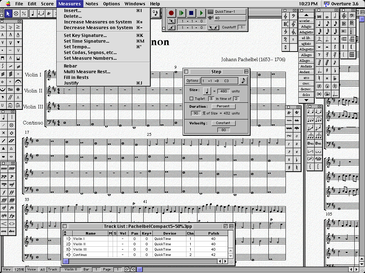Overture To Oberon Program Notes
Overture to Oberon. Carl Maria von. Wings until a double fortissimo chord ushers in the Overture's main. Contribute to the Philharmonic program book. Program Notes: Classics Season. Movies In Concert. The Nutcracker. Most of the melodies of the exciting and vibrant overture to Oberon are all taken from the. ‘German Idylls’ Program Notes Carl Maria von Weber – Oberon: Overture Growing up on the road with his father’s traveling theater company, Carl Maria von Weber had an unusual childhood by almost any measure.
SUBSCRIBE to our videos: Filmed in High Definition 1080p University of Hawai'i at Mānoa College of Arts and Humanities Department of Music presents: University of Hawai'i Bands 2011 Aloha Concert @ McKinley High School Auditorium April 25, 2011 Under the direction of Keith Higaki This is the 2011 Wind Ensemble performing: 'Overture to Oberon' by Carl Maria von Weber trans. Mayhew Lake.No Third Party copyright intended. 'Copyright Disclaimer Under Section 107 of the Copyright Act 1976, allowance is made for 'fair use' for purposes such as criticism, comment, news reporting, teaching, scholarship, and research. Fair use is a use permitted by copyright statute that might otherwise be infringing. Non-profit, educational or personal use tips the balance in favor of fair use.' Program Notes: Carl Maria von Weber was perhaps more responsible than any other German composer for paving the way for a German-language opera style. Weber, a music critic, conductor, and pianist, sought to bring music to the burgeoning middle-class, especially music they could relate to and understand.
Overture To Oberon
His folk-legend operas were a deliberate turn from the lofty mythological stories of French and Italian operas. He influenced a whole generation of German composers, including Felix Mendelssohn and Richard Wagner. The overtures to Weber's three greatest operas, Der Freischutz, Euryanthe, and Oberon, have become favorites of the concert-going public and are mainstays of the standard orchestra repertoire. The overture beings with a slow introduction (Adagio sostenuto), launcehd by a call from Oberon's magic horn. A bracing fff chord leads to the principal Allegro con fuco, featuring several melodies from the opera.
Among them is Rezia's aria - 'ocean! Though mighty monster!'
- which provides the basis for the overture's majestic conclusion.Sony NEX-VG10 -Kit Lens (18-200mm) -Aperture Priority (1/30 F5).Audio (NEX-VG10 Stock Mic).

Contents. Overture The Overture in, Op. 21, was written by Mendelssohn at 17 years and 6 months old (it was finished on 6 August 1826). Contemporary music scholar called it 'the greatest marvel of early maturity that the world has ever seen in music'. It was written as a concert overture, not associated with any performance of the play. The Overture was written after Mendelssohn had read a German translation of the play in 1826. The translation was by, with help from.
There was a family connection as well: Schlegel's brother married Felix Mendelssohn's. While a piece in atmosphere, the Overture incorporates many elements, being cast in and shaped by regular phrasings and harmonic transitions. The piece is also noted for its striking instrumental effects, such as the emulation of scampering 'fairy feet' at the beginning and the braying of Bottom as an ass (effects which were influenced by the aesthetic ideas and suggestions of Mendelssohn's friend at the time, ). Heinrich Eduard Jacob, in his biography of the composer, said that Mendelssohn had scribbled the chords after hearing an evening breeze rustle the leaves in the garden of the family's home. The overture begins with four chords in the winds. Following the first theme in the parallel minor representing the dancing fairies, a transition (the royal music of the court of Athens) leads to a second theme, that of the lovers. This is followed by the braying of Bottom with the 'hee-hawing' being evoked by the strings.
A final group of themes, reminiscent of craftsmen and hunting calls, brings the to a close. The fairies dominate most of the section, while the Lover's theme is played in a minor key. The recapitulation begins with the same opening four chords in the winds, followed by the Fairies theme and the other section in the second theme, including Bottom's braying. The fairies return, and ultimately have the final word in the, just as in Shakespeare's play. The overture ends once again with the same opening four chords by the winds.
The Overture was premiered in Stettin (then in; now, ) on 20 February 1827, at a concert conducted. Mendelssohn had turned 18 just over two weeks earlier.
He had to travel 80 miles through a raging snowstorm to get to the concert, which was his first public appearance. Loewe and Mendelssohn also appeared as soloists in Mendelssohn's Concerto in A-flat major for two pianos and orchestra, and Mendelssohn alone was the soloist for 's. After the intermission, he joined the first violins for a performance of 's. The first British performance of the Overture was conducted by Mendelssohn himself, on 24 June 1829, at the in London, at a concert in benefit of the victims of the floods in, and played by an orchestra that had been assembled by Mendelssohn's friend Sir. Incidental music. ^ Grove's Dictionary of Music and Musicians, 5th ed., 1954. Grove, Sir George (November 1, 1903). Hauppauge wintv-hvr-950q.
'Mendelssohn's Overture to 'A Midsummer Night's Dream '. The Musical Times. 44 (729): 728. Archived from on August 7, 2008.
Retrieved 2013-06-30. Retrieved 2013-06-30. Retrieved 2013-06-30. Retrieved 2013-06-30.
Retrieved 2013-06-30. Retrieved 2013-06-30. Harvey, Adam. McFarland & Company, Incorporated Publishers. External links. Media related to at Wikimedia Commons.
at the.